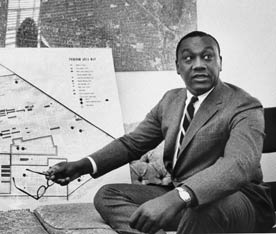This trend is also true for other parts of the country, but resource constraints make it a bigger challenge in the Gulf region. Community development practitioners have illustrated how networks can foster real engagement by mobilizing residents to create a “strong demand environment for change,” as Bill Traynor discusses in his 2005 article in Shelterforce, “Network Organizing: A Strategy for Building Community Engagement.” Given the post-disaster context of the Gulf Coast, where there is a strong demand for change, a resurgent social movement, the fact that thousands are still displaced, and the fact that emergent national alliances such as Right to the City have made New Orleans a priority, a network strategy seems to be a practical and strategic approach for fostering maximum inclusion and enabling democratic practices.
In the networked approach to governance, what becomes more important is to learn how to manage organizations that are composed more of networks instead of individuals and programs. In the case of Gulf Coast rebuilding, the values and guiding principles of the emergent leadership are aligned with the organizing principles of network development — which include flexibility, change, choice, and relationships that are more suited to the context of rebuilding rather than a traditional institution-building approach.
CSI is thus organizing convenings, meetings, and other forms of networking in the region, in addition to providing research and policy support to groups working in the region.
Our goals are to:
1.Align strategies and strengthen existing work. Leaders can connect with local and state efforts, share strategies and lessons learned, consider shared priorities for collective action, and identify and strategize around gaps. These strategies can then feed into existing efforts aimed at affecting local, state, and federal policies and programs.
2.Build community capacity through policy recommendations and advocacy strategies. By developing strategies that are directly connected to Gulf Coast communities, local leaders can better hold national organizations accountable and leverage national resources and support.
3.Create long-term regional transformation. Leaders grounded in shared principles and connected beyond geography, issues, and expertise can serve as a continued resource for strategizing and mobilizing beyond the life of specific efforts.
We believe that local leaders can help the nation see the benefits in rebuilding the Gulf Coast and forming the policies necessary to build healthy communities, particularly for communities of color. To do so, leaders across the region need to be connected with one another in order to think collectively, strategically, and long-term.
Alliances can form beyond what is traditionally considered grass-roots, recognizing that post-Katrina and Rita rebuilding affects a wide range of community members. Leaders will be able to pursue strategies that benefit all communities. Under the right circumstances, national leaders can emerge from the resurgent social and civil-rights movement of the post-Katrina South.
We believe that to nurture emergent leaders, funders should: 1) provide core support grants to stabilize and build existing organizations and invest in community leaders with a track record of alliance-building and collaborative work; 2) invest in relationship- and network-building within states and across the region; and 3) provide financial and technical assistance for developing community infrastructure.
National advocacy groups also have a critical role to play, including actively engaging in resource-sharing and other in-kind support. National and intermediary organizations should publicly acknowledge the contributions of local groups and leaders who have enabled their work and successes and should include local groups and leaders in meetings with funders, donors, and policymakers when discussing the needs of the region.
Two years after New Orleans’ levees broke, thousands, mostly people of color, remain displaced, unable to rebuild their lives and homes in the Gulf Coast region. The problem, as this nation was forced to acknowledge, was not a hurricane, but decades of flawed public policies and discriminating institutions that created such a concentration of poverty.
Race has been an architect of our institutions and policies, and the structures that determine opportunity and well-being continue to be stacked against people of color, women, children, and other vulnerable populations. Seen from this perspective, it is not hard to understand why they are having the most difficulty rebuilding their lives even now. And yet, the crisis has ignited powerful grass-roots mobilization that is giving new meaning to community-building and leadership.
What has emerged, or has become visible, is a wealth of leadership. Many are young women of color, who share values and a common understanding of what kind of communities we want to build and the kinds of physical, social, economic, and political infrastructures are needed to sustain them. The importance of this shared value system cannot be overemphasized. If democracy is government by discussion, and not just about elections, then the greater the participation by the people who are excluded from the market because of systemic or structural biases, such as race or gender, or because of the outcomes of those biases, such as illiteracy or poor health, the better.
At the same time, power involves having the ability to negotiate and set the agenda, make and enforce the rules, determine how resources will be allocated, and communicate without barriers. Given the violently repressive history of the region and the current concentration of wealth and power, building community power and leadership will require an explicit acknowledgement of the inequalities of power — from the traditions of exclusion to the social networks that sustain them.





Comments